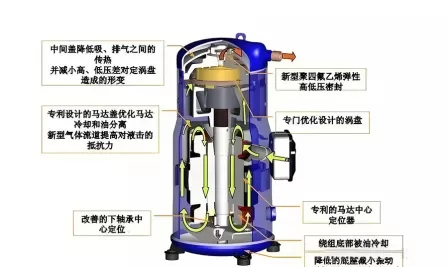Principle of operation of refrigeration compressors
Feb. 27, 2025
The refrigeration compressor is the core component of a refrigeration system and plays a key role in converting low pressure gases into high pressure gases to drive the entire refrigeration cycle. In this paper, the working principle of the refrigeration compressor will be explained in detail and an attempt will be made to show the process in a textual description together with conceptual illustrations.
Overview of Refrigeration Compressor
Refrigeration compressor is a low-pressure refrigerant gas inhalation, through mechanical work will be compressed into high-pressure high-temperature gas, and then discharged to the condenser mechanical equipment. It is the heart of the refrigeration system, for the refrigeration cycle to provide the necessary power. Refrigeration compressor is widely used in household air conditioning, commercial freezers, industrial refrigeration and other fields.

The working principle of refrigeration compressor
Refrigeration compressor working principle can be summarised as four main steps: suction, compression, condensation, expansion and evaporation. The following is a detailed description of the process:
1. suction process
Compressor start, low temperature and low pressure refrigerant gas through the suction pipe is sucked into the compressor. This process is usually controlled by a device called a ‘suction valve’, which ensures that the gas enters the compression chamber smoothly.
2. Compression process
Further reading:Ultimate Guide for Purchasing an Induction Forging Machine
The inhaled refrigerant gas is compressed inside the compressor by a mechanism such as a piston or rotor, reducing its volume and increasing its pressure and temperature. Different types of compressors (e.g. piston, screw, centrifugal, etc.) have different compression mechanisms, but the basic principle is the same.
3. Condensation process
The high temperature and high pressure refrigerant gas leaves the compressor and enters the condenser. In the condenser, the refrigerant gas transfers heat to its surroundings (e.g. air or water), where it cools and condenses into a liquid. This process causes the temperature of the refrigerant to decrease, but the pressure remains high.
4. Expansion and evaporation processes
The refrigerant liquid from the condenser is depressurised through the expansion valve, the volume expands and the temperature is further reduced to form a low pressure, low temperature mist refrigerant liquid. These liquids then enter the evaporator, evaporates into gas in the evaporator, absorbs the heat of the surrounding air, to achieve the cooling effect. The evaporated refrigerant gas is again drawn in by the compressor to start a new round of circulation.
Type and application of refrigeration compressor
Refrigeration compressors can be divided into a variety of types, such as piston, screw, centrifugal, etc., according to the principle of operation and structural characteristics. Each type of compressor has its own unique application scenarios and advantages. For example, piston compressors are suitable for small refrigeration equipment, while screw compressors are widely used in medium and large refrigeration systems.
IV. Conclusion
The refrigeration compressor realises the circulation of refrigerant and the transfer of heat through four main steps: suction, compression, condensation, expansion and evaporation. It is an indispensable core component of the refrigeration system, providing the necessary power for the refrigeration process. Understanding the working principle of the refrigeration compressor is important for optimising the design of the refrigeration system and improving the refrigeration efficiency.
85
0
0
All Comments (0)
Previous: None
Next: None
If you are interested in sending in a Guest Blogger Submission,welcome to write for us!


Comments